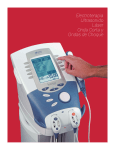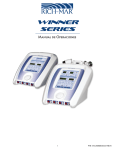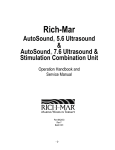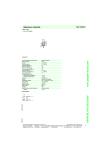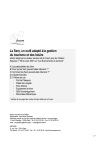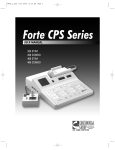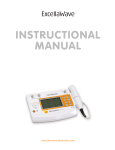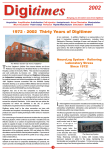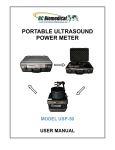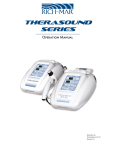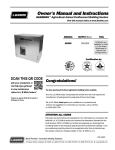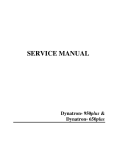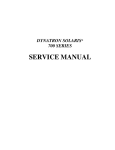Download Winner - Rich-Mar Corporation
Transcript
Winner BY R I C H - M A R Winner Operation and Service Manual For the Following Models: CM4 - CM4P - CM4-5 - CM4-5P - CM4-10 - CM4-10P CM2 - CM2P - CM2-5 - CM2-5P - CM2-10 - CM2-10P ST4 - ST4P- ST2 - ST2P Part # MN 2448 Rev. H Batch #001 800.762.4665 - 918.543.2222 CAUTION The operator should read and be familiar with the precautions and operation of this device prior to beginning treatments. This device is not designed to be connected with any electrical equipment or accessories unless manufactured and/or approved by Rich-Mar. This includes whirpools, lead cords, probes, self-adhesive electrodes and carbon electrodes NOT manufactured by Rich-Mar. WARNING Federal law restricts this device to sale by or on the order of a pyhsician or any other practitioner licensed by the law of the state in which said person practices. For continued protection against fire hazard, replace fuses ONLY with those of the same type and rating. This equipment should always be grounded. Grounding reliability can only be achieved when the equipment is connected to an equivalent marked, “Hospital Grade.” This device should be kept out of the reach of children. TABLE OF CONTENTS Winner Warranty....................................................................4 Introduction.......................................................................... 5 Winner Operation................................................................... 5 Overview....................................................................... 5 Stimulation Operation....................................................... 5 Stimulation Waveforms and Modes..................................... 6 CM4 Models Panel Illustration........................................... 7 CM2 Models Panel Illustration........................................... 8 ST4 Models Panel Illustration............................................ 9 ST2 Models Panel Illustration............................................ 10 Stimulations Waveform Defaults & Therapy Profiles..............11 Lead Cord Tester............................................................. 12 Ultrasound Operation (CM Models only).................................... 12 Combination Operation (CM Models only).................................. 14 Electrode Site Preparation & Guidelines............................... 15 Patient Electrode Connection................................................ 16 Stimulation Indications for Treatment..................................17 Microcurrent Indications for Treatment................................ 17 Ultrasound Indications for Treatment...................................17 Stimulation Contraindications & Warnings.......................... 18 Microcurrent Contraindications & Warnings........................ 18 Ultrasound Contraindications & Warnings........................... 19 Waveform Specifications.......................................................20 Ultrasound Calibration & Tuning Procedures (CM Models only).... 23 Cleaning Recommendations...................................................24 Converting between 230 VAC and 115 VAC.........................24 Trouble Shooting................................................................... 25 Winner Specifications & Accessories List............................. 25 Ultrasound Technical Information.........................................26 Appendix A Ultrasound Technical Information Service Manual available on our website www.richmarweb.com LIMITED WARRANTY This equipment is sold under an exclusive one-year warranty from date of sale, which warrants it to be free from defects in material and workmanship. We agree to repair or replace at the point of manufacture, without charge, all parts showing such defects, provided the unit is delivered to us, prepaid to our factory, intact for our examination, within one year from date of sale, and provided such examination discloses in our final judgement that it is defective. This warranty does not apply if the equipment has been subject to misuse, neglect, accidents, incorrect wiring (not our own), improper installation, or put to use in violation of instructions furnished by us, has been damaged by excess voltage or has been repaired or altered outside our factory or if the equipment has had its serial number altered or removed. Changes: Rich-Mar reserves the right to modify or change the equipment in whole or in part, at any time prior to delivery, in order to include refinements deemed appropriate by the Company but without incurring any liability to modify or change equipment previously delivered, or to supply new equipment in accordance with earlier specifications. This warranty will be honored only if the enclosed card is filled out and returned to the factory. This warranty is valid only to original purchaser. This warranty is expressly in lieu of all other warranties expressed or implied including the warranties of merchantability and fitness for use and all other obligations on our part, and we neither assume, nor authorize any other person to assume for us, any other liability in connection with the sale or use of this equipment. In no event shall we be liable for consequential or special damages. We make no warranty whatsoever in respect to accessories or parts not supplied by us. 4 Introduction The Winner units are products that resulted from dedication to research and development. The Winner units offer the most flexible treatment possibilities in a convenient, easy-to-use package. This manual is meant to familiarize the user with the controls, operations, waveforms and ultrasound therapies available in the Winner units. The simple control of the unit allows the user to master the unit’s vast capabilities more quickly and easily. User Interface The Winner units use a straightforward control panel with each waveform therapy and parameter clearly labeled. Each button requires only light pressure to be activated. You should also hear an audible beep each time a button is pressed. LED lights illuminate indicating the availability and/or selection of particular parameters. The large and bright LED numerical displays show treatment time, intensity and pulse rates. Power Switch This power switch turns the unit on and off and is located on the rear side of the unit. “I” represents the on position and “O” represents the off position. Winner Operation Overview Overview The Winner Series offers a variety of different devices to fit your therapy needs: The CM4 models (CM4, CM4P, CM4-5, CM4-5P, CM4-10, CM4-10P) are four-channel, multi-therapy stimulationultrasound combination units. The Winner CM2 models (CM2, CM2P, CM2-5, CM2-5P, CM2-10, CM2-10P) are the two channel combination version. The ST4 and ST4P are the four-channel multi-waveform stimulators, and the ST2 and ST2P are the twochannel versions. The Winner units will output any one of the following waveforms: Quadpolar IFC (Classic Interferential) , Premod IFC (Bipolar Interferential), Russian, Hi-Volt, and Microcurrent. Depending upon the waveform in use, any one of the following treatment modes can also be used: Normal output, Surge output, Co-Contraction output, and Alternating channel output. (NOTE: For more information on outputs, see the “Waveforms” section.) The Winner CM4 and CM2 can also provide 1MHz and 3MHz ultrasound frequencies via the unique, patented “Therapy Hammer” transducer with a 2cm2 soundhead on one side and a 5cm2 soundhead on the other. *CM4-5, CM4-5P, CM2-5, and CM2-5P provide a 1 & 3 MHz 5cm2 soundhead. **CM4-10, CM4-10P, CM2-10, and CM2-10P provide a10cm2 1 MHz soundhead. Stimulation Once the device is turned on, you will notice that the green LED lights in the Waveforms (Quadpolar IFC, Pre-Mod IFC, Russian, HiVolt and Micro) and the Therapy Profiles are blinking. This is to indicate that the unit is on and ready for treatment. It is also a quick reference to determine if the device is in the Easy Therapy Profile mode or Advanced Therapy Profile mode (see Therapy Profile section for more information). *NEW Feature: If no treatments are running and no buttons are pressed the device will go into a “sleep mode” where the LEDs will not blink on the stimulator side. Simply press any button to re-activate the stimulator. To Start a Stim Treatment Press the button of the desired Waveform or Therapy Profile. Once you do this you will notice that the device has selected the first available channel(s). For example, if you turn on the device and press the Pre-Mod IFC button, the green LED next to Selected in the Ch. 1 button will illuminate. This indicates that the treatment will output from Ch. 1 and you should use that lead cord to apply the electrodes. Or... * NEW Feature: You can now select the CHANNEL you want to use by first pressing that channel’s button. You will then notice that the Waveform/Profile LEDs are blinking. You then select the waveform or profile you would like to use by pressing it’s button. However you have selected to begin your treatment (either picking the waveform first or the channel button first) you will then notice that certain LEDs have been illuminated indicating that they are currently selected. Using the example above of Pre-Mod IFC, the LEDs are lit next to Normal, a High pulse Rate and 15:00 minutes of treatment time. You can change any of these parameters by pressing the appropriate button(s) noticing that the LED lights change too. Once the desired parameters are displayed, the Winner devices will prompt you to set Intensity by flashing the Adjust LED light underneath the Intensity dial. As you set the desired intensity level, you will notice that the green Active light is illuminated in the Ch. 1 button to indicate that current is being output. Once the desired intensity level has been set press the Start/Accept button and the time begins counting down. NOTE: When using Quadpolar IFC one of the channel pair’s Selected light will blink. If you balance the treatment then the intensity display will be different between the two channels. Whichever channel’s Selected light is constantly illuminated will display its intensity level. Running Concurrent Stim Treatments The Winner units have either four independent stimulation channels (CM4 and ST4 models) or two independent stimulation channels (CM2 and ST2 models). This allows you to treat four or two different sites or patients at the same time with completely 5 different treatment parameters. To start a concurrent stim treatment press the desired waveform or Therapy Profile or channel for the second treatment. If you pressed the Waveform or Profile button the green Selected LED light in the Ch. 2 button should now be illuminated. If you pressed a channel button than that channel’s Selected LED should be illuminated. You will also notice that the green Selected LED light on Ch. 1 went out but its green Active LED light is still illuminated. This means that there is a treatment currently on Ch. 1 but its parameters are not selected for display. If you pressed the waveform or Profile button the treatment parameters on Ch.2 are now displayed. If you pressed a channel button you now need to select the waveform or Profile you want to use and its parameters will be displayed. Any adjustments can now be made to the parameters for this second treatment. Then, set Intensity and press the Start/Accept button to begin the treatment time countdown. NOTE: If the Quadpolar IFC therapy waveform is selected, it requires both channels one and two or channels three and four and will subsequently set the same intensity level on both channels. Once the intensity levels are set in Quadpolar IFC and the Start/Accept button has been pressed, you have the option of Balancing the output by pressing the Balance button. When pressed, the green LED light on the Balance button will illuminate and the green Adjust LED light will illuminate under the intensity dial. Use the dial to balance the patient’s sensation. You will see only the selected channel’s intensity level increase or decrease, but understand that as it increases, the other Quad IFC channel’s intensity decreases proportionately. Once the balance has been completed, press the Start/Accept button. sensation balance if that button is selected - as you increase or decrease intensity on the selected channel it will do the opposite on the other channel in the pair. Quadpolar IFC also allows you to turn an amplitude modulating Vector on or off. The Vector provides a soothing massage effect and also helps to lessen patient accomodation. The Pulse Rate available is either the High, Low or a Hi-Lo combination. Pre-Mod IFC will output pre-modulated, two-pad Interferential current in any of the desired Modes (Normal, Surge, Co-Cont and Alternating). The Vector can be turned on or off in the Normal mode. The Pulse Rates available in the Normal mode are High, Low, and Hi-Lo scan. If the Surge, Co-Contraction, or Alternating mode is selected, only the Fixed Pulse Rate is available. Any of the six On/Off timing options are available in the Surge or CoCont modes. In the Alternating mode the 10/10 or the 5/5 timing cycles are available. Russian and Hi-Volt- Both waveforms are available in any of the Modes (Normal, Surge, Co-Cont, and Alternating). The Fixed Pulse Rate is only available for Russian. *NEW Feature: The Hi-Volt Pulse Rates now available in the Normal mode are High, Low, and Hi-Lo scan. If the Surge, CoContraction, or Alternating mode is selected, only the Fixed Pulse Rate is available. Any of the six On/Off timing options are available in the Surge or Co-Cont modes. In the Alternating mode, the 10/10 or the 5/5 timing cycles are available. NOTE: The Hi-Volt in the Winner is a non-dispersive style. This means that for each channel, one of the electrodes is positive and the other is negative. When using the Hi-Volt waveform, the red pin is positive and the white pin is negative. To View Stimulation Treatments If you are running two or more concurrent stim treatments, you will only see one treatment’s parameters at a time. Press the desired channel button to illuminate its Selected LED light. You will then see all the parameters for that particular channel’s treatment. Whichever channel button you press will activate the Selected LED and display that treatment’s parameters. Microcurrent will only output in a Normal mode and its Pulse Rate is only available as a Fixed output. To Stop a Stimulation Treatment If you only want to stop a single treatment without affecting the other treatments, press and hold the desired channel button and the stimulation Stop button at the same time. - If you just press the stimulation’s Stop button it WILL STOP ALL STIM TREATMENTS. Stimulation Modes Depending upon the waveform selected, the user can choose from Normal, Surge, Co-Contract and Alternating modes. Normal Mode is basic continuous, un-interrupted output of the selected waveform. Waveform Parameter Options Waveform choices include Quadpolar IFC, Pre-Mod IFC, Russian, Hi-Volt (Monophasic), and Microcurrent. Quadpolar IFC will only output classic Interferential current in a Normal mode and it requires both Ch.1 and Ch. 2 or Ch. 3 and Ch. 4 (if applicable). The Balance button allows for better patient 6 Surge Mode is a single channel of output that is interrupted in an “on/off” method of a certain time, in seconds, of output followed by a certain time, in seconds, of no output. For example, if Surge mode is selected and the “10/20” option is selected, this means that for 10 seconds there will be output to the set intensity level followed by 20 seconds of zero output. The cycle continues until treatment time expires. * NOTE: There 7 *CM4-5 and CM4-5P will only have a 5cm 2 transducer indicator. **CM4-10 and CM4-10P will only have a 10cm 2 transducer indicator and will only output 1MHz frequency. Winner CM4 models (CM4, CM4P, CM4-5*, CM4-5P*, CM4-10**, CM4-10P**) Panel 8 *CM2-5 and CM2-5P will only have a 5cm 2 transducer indicator. **CM2-10 and CM2-10P will only have a 10cm 2 transducer indicator and will only output 1MHz frequency. Winner CM2 models (CM2, CM2P, CM2-5*, CM2-5P*, CM2-10**, CM2-10P**) Panel 9 Winner ST4 & ST4P Panel 10 Winner ST2 & ST2P Panel is a built-in ramp up time of three seconds in the “on” time and a ramp down of one second in the “off” time. Co-Contraction Mode is the same as the Surge mode except that it will concurrently run two channels, either 1 and 2 or 3 and 4, to the same “on” and “off” time. Independent intensity levels can be set. Alternating Channel Mode will alternately turn one channel “on” and then a second channel “on” as soon as the first channel goes into the “off” time. For example, in an Alt mode both Ch. 1 and Ch. 2 will be used. If the “10/10” option is selected in the Time On/Off then, after intensity levels have been set for each channel and treatment started, Ch. 1 will be “on” for 10 seconds. Once Ch.1 goes “off”, Ch. 2 will be “on” for 10 seconds. This alternating will continue until treatment time expires. To Adjust Stimulation Intensity during Treatment Intensity can be adjusted during treatment, even during the off cycle in Surge or Alternating modes, simply by pressing the desired Channel button. Normal mode intensity adjustment- When in Normal Mode, you will notice that the light in the Start/Accept button is flashing. Once the level is adjusted, press Start/Accept and the user will be prompted to do the same for channel two, if applicable. Timing Mode Intensity Adjustment- Surge, Co-Cont & Alt Surge Mode Intensity Adjustment - In the Surge mode, press the Channel button and you will notice that the Start button is blinking. Press the Start button to access a change in intensity as a safety feature. You will then notice that the time has stopped counting down and the channel’s Active LED is illuminated. Make your intensity adjustment and press the Start button when finished. The timing cycle will now start over. This process is done as a safety feature so that you cannot increase intensity during the “off” cycle. Co-Contract or Alternating Modes Intensity AdjustmentThese modes use two channels so you need to press the button for the Channel that you want to adjust. Once you do this, notice that the Start button is blinking. You cannot change the intensity until you press the Start button. Press the Start button and the treatment’s other channel Active LED goes out, the selected channel’s Active LED illuminates, and the Timer stops counting down. Make your intensity adjustment and press the Start button when finished. The timing cycle will now start over. This process is done as a safety feature so that you cannot increase intensity during the “off” cycle. the Pulse Rate View/Adjust button. If a Scan is selected, the low end of the Scan will be displayed in the Stim Time display but note that the Pulse 1 light is illuminated. The high end of the Scan will be displayed in the Stim Intensity display but note that the Pulse 2 light is illuminated now. At this point you can make adjustments to either end of the Scan by using the up/down arrows for Pulse 1 and the dial for Pulse 2. Once the Pulse Rate has been selected press the Start/Accept button. The High Scan and Low Scan will make a complete cycle through the selected pulse rate range in 30 seconds. For example, if a 100-120 scan is selected it will start at 100 Hz and scan up to 120Hz and back down to 100Hz every 30 seconds. The High-Low Scan pulse rate mode will split the treatment time in half with the first half using the High pulse rate scan and the second half using the Low pulse rate scan. To set up a Hi-Lo pulse rate scan set the High scan and then the Low scan and select the Hi-Lo Pulse Rate. Follow these steps: -Press the Pulse Rate button and select High pulse rate. -Press the Pulse Rate View Adjust button and set the desired High scan. -Press the Pulse Rate View button again. -Press the Pulse Rate Mode button to select the Low pulse rate. -Press the Pulse Rate View Adjust button and set the desired Low scan. -Press the Pulse Rate View button again. -Now press the Pulse Rate Mode button until the High-Low is selected(both LEDS will be lit for High and Low. -Set time and intensity and begin treatment. *NEW Feature: The LED of the pulse rate that is currently running in the High-Low scan will be constantly lit and while the other scan’s LED will be blinking. Example: You start a treatment in the High-Low Scan and the High LED is constant and the Low LED is blinking. This indicates the that High scan is currently outputting. You can verify this by pressing the Pulse Rate View Adjust. Fixed Pulse Rate- If Fixed pulse rate is selected and the Pulse Rate View/Adjust button has been pressed, the pulse rate is displayed in the Stim Time display and the Pulse 1 light is illuminted. Make adjustments to the fixed pulse rate by using the up/down arrows or the dial. After selecting Pulse Rate press the Pulse Rate View/ Adjust button. Stimulation Pulse Rates Depending upon the waveform selected, the user can use either a Scan (High, Low or Hi-Lo) or a Fixed pulse rate. Once the type of pulse rate has been selected (High, Low, Hi-Lo or Fixed), press Stimulation Treatment Time Treatment time for the Winner stimulation is adjustable from 199 minutes. You can adjust treatment time in one minute 11 increments at any time by pressing the increase or decrease buttons below the treatment time during the displayed treatment. under that Therapy Profile and can be accessed by pressing that Profile button. You may want to name and note the treatment on the included Easy Mode Profile Reference card under Waveforms/ Profiles. Setting Waveform Defaults and Therapy Profiles Easy Therapy Profile Use Once you have set your Easy Profiles, simply press the desired Profile (A, B, C, or D). The LED for that Profile should illuminate along with the waveform and parameters of the treatment. Simply set the intensity level and press start to begin the treatment. Waveform Defaults- To set particular parameters so that they are defaults for a Waveform button, select the Waveform and set all the parameters as desired: Treatment time, Mode, Time On/ Off (if applicable) and Pulse Rate. Once all parameters are selected, set the Intensity and PRESS AND HOLD THE START/ ACCEPT BUTTON UNTIL YOU HEAR TWO CLICKS AND A LONG TRILL. When this occurs, it has stored those displayed parameters as the default for that waveform. Repeat this process for each waveform. Advanced Therapy Profile Mode Set-up To set a Profile in the Advanced mode, you must first press the waveform and then press the desired Profile (A, B, C or D). For example, press Quadpolar then profile A. You will see that there is a treatment default already programmed. To change the treatment, simply select the parameters you want for that waveform profile, set intensity and PRESS AND HOLD THE START/ACCEPT BUTTON UNTIL YOU HEAR TWO CLICKS AND A LONG TRILL. This indicates that the treatment is saved as a profile for that waveform. You may want to name and note the treatment on the included waveform specific Profile Reference card. Use the Advanced Mode Profile Reference cards. In this case, it would be the Quad/Pre-Mod card. There are also cards for Russian/Hi-Volt and Micro/Support. For example, if you wanted to change the Pre-Mod defaults to a Surge treatment: - Press the PreMod IFC button, - Select the Surge Mode, - Select the 10/10 Timing Cycle. - Press the Pulse Rate View Adjust and set a 65 Hz pulse rate and press the Pulse Rate View Adjust again - Set the Treatment Time for 8 minutes. - Turn the dial to set the intensity and PRESS AND HOLD THE START BUTTON UNTIL YOU HEAR TWO CLICKS AND A LONG TRILL. Now, whenever you press the PreMod IFC button, it will come up with the above treatment. Therapy Profiles - The Winner devices will allow you to use either the Easy Therapy Profile mode or the Advanced Therapy Profile mode. The Easy Therapy Profile mode allows you to set a total of four different therapies so you can start a treatment with one touch. The Advanced Therapy Profile mode will allow you to have four different profiles for each waveform, giving you a total of 20 Therapy Profiles. If the device is in the Easy Therapy Profile mode, the Profile LEDs will blink along with the waveform LEDs when the device is first powered on. If the device is in the Advanced Therapy Profile mode, the Profile LEDs will not blink when the device is first turned on. To switch from one Therapy Profile mode to another, turn the device off, press and hold any of the Therapy Profiles, and turn the device on. You should hear a series of beeps and notice that the Profile LEDs are now in the opposite mode. Advanced Therapy Profile Use Once you have set your Advanced Profiles, simply press the desired waveform and then the desired Profile (A, B, C, or D). The LED for that Profile should illuminate along with the waveform and parameters of the treatment. Simply set the intensity level and press start to begin the treatment. Lead Cord Tester The Winners have a set of lead jacks on the left side of the unit. Plug in your lead cord and touch the tips together. You should hear a beep to let you know your leads are good. If you hear no beep then you need to replace your lead cord. Ultrasound - CM Models Only The ultrasound function of the Winner CM4 and CM2 is very easy to use. Once the machine is turned on, the last treatment’s parameters will be displayed. If this is the desired treatment set the intensity with its up/down arrows and press the Start button. The Ultrasound Active light illuminates and the Time is blinking indicating that ultrasound is being output and time is counting down. Easy Therapy Profile Mode Set-up To set a Profile in the Easy mode, press the desired Profile button (A, B, C, or D) TWICE. Then, select the desired waveform and all its parameters. Set the intensity and PRESS AND HOLD THE START/ACCEPT BUTTON UNTIL YOU HEAR TWO CLICKS AND A LONG TRILL. This indicates that the treatment is stored *NOTE: Be sure to use Aloe-Sound Lotion or Gel Plus as a coupling agent and place the appropriate soundhead on the 12 patient. Remember to always move the soundhead, approximately 4cm/second either in a circular or back and forth motion. If you want to change ultrasound parameters select from the following list: Transducer CM4, CM4P, CM2, CM2P -Select either the 2cm2 or 5cm2 transducer. *CM4-5, CM4-5P, CM2-5, CM2-5P 5cm2 transducer only. **CM4-10, CM4-10P, CM2-10, CM2-10P 10cm2 transducer only. Frequency Select from 1MHz or 3MHz. Remember that the lower the frequency, the deeper the penetration, if intensity levels are equal. 1MHz is a lower frequency than the 3MHz. ** CM4-10, CM4-10P, CM2-10, CM2-10P are 1MHz only. Ultrasound Wattage (Output) The Winner will display output in either W/cm2 or Watts. Select the output display by pressing the Select button next to the intensity up/down arrows. Duty Cycle Pulsed outputs can be selected from 10%, 20% or 50%, or 100%. Treatment Time Select the desired treatment time between 1 and 99 minutes. To Adjust Ultrasound Parameters During Treatment You can adjust Treatment Time, Intensity,Transducer, Duty Cycle and Frequency at any time during the treatment by using the appropriate control. To Pause An Ultrasound Treatment Once an ultrasound treatment is running, pause it by pressing the Pause/Resume button. The time will stop flashing, the Ultrasound Active light will go out and the Intensity will start flashing - indicating a paused treatment. To resume treatment, press the Pause/ Resume button. 13 CAUTION: Do not operate the soundhead in an unloaded condition (without Aloe-Sound coupling Lotion/Gel and patient contact). This can cause the transducer to get very hot and may cause unrepairable damage. NOTE: When administering an ultrasound treatment, be sure that the treatment area of the patient has an ample quantity of Rich-Mar Aloe-Sound Lotion or Gel Plus as a coupling medium. The quantity and quality of the coupling medium used has a direct bearing on the amount of ultrasonic energy transmitted to the treatment area. Combo - CM Models Only Figure 1 The Winner CM4 and CM2 units allows the user to combine a stim treatment with an ultrasound treatment by emitting stimulation and ultrasound through the soundhead at the same time. Quick and easy “self-jacking” can be accomplished by taking the lead cord from the stim channel you want to use and plug the desired lead tip into the special ultrasound jack for combination therapy. - Plug the leadcord into the red jack of whatever channel you are using for stim. - Apply the electrode to the desire lead tip (figure 2) and put it on the patient. - Then, plug the pin end of the other side of the lead into the small silver stim jack on the right side of the ultrasound cable (figure 3). This makes the soundhead function as that electrode. - Apply the Aloe-Sound Coupling Lotion or Gel to the site and apply the soundhead to the patient. This completes the stimulation circuit(figure 4) and the stimulation component of the treatment may now be set up. Once the parameters are selected, set the stim intensity level. The patient should feel the stimulation. Set the ultrasound parameters making sure to move the soundhead once you are outputting ultrasound (Ultrasound Active light comes on). You are now providing a combination therapy treatment. Figure 2 Figure 3 NOTE: Both the 2cm2 and 5cm2 sides of the “Therapy Hammer” will emit stimulation in the combo setup (CM4, CM4P, CM2, CM2P only). NOTE: Both contraindications for ultrasound and stimulation should be observed when using the device in combination. Figure 4 14 Electrical Stimulation Site Preparation, Electrode Attachment, and Maintenance Guidelines REMOVAL AND STORAGE OF ELECTRODES: Turn off the stimulation device and disconnect the cabling. Remove the electrodes from the skin and reapply to the plastic backing. Place in the pouch and reseal for storage to maintain proper adhesive quality when not in use. If possible, store the electrodes in a refrigerator to maintain adhesive. 1) Know the stimulation characteristics, indications, and contraindications of the desired waveform. For most patients, the Micro amperage current will be sub-sensory. However, if stimulation sensation is perceived, be sure it is set at a level that is comfortable for the patient. On all other muscle stimulation and interferential current therapies, be sure that the intensity is set to a comfortable level. DO NOT BRING UP THE INTENSITY UNTIL THE FOLLOWING PROCEDURES HAVE BEEN OBSERVED. 2) Clean the area(s) of the skin to be treated with soap and water or an alcohol wipe. 3) Excessive hair may be trimmed, but shaving is not recommended immediately prior to electrode placement. 4) Choose the appropriate size electrode(s) for the body part being treated. 5) Be sure that the electrodes are securely attached to the lead wires. See the illustration on the following page for the appropriate patient lead wire connections. 6) Avoid placing an electrode over areas of broken skin, scars, moles, or unusual areas of skin discoloration. Also avoid skin folds/creases or areas of impaired sensation. 7) The single patient self-adhesive electrodes are well suited for most body areas in which electrical stimulation would be used. Remove the electrodes from the pouch and save it for subsequent storage of the product. Carefully peel the electrodes from the release backing and apply it to the chosen site. Press firmly to ensure uniform and secure contact with the skin and begin stimulation treatment. CAUTION: In multiple, consecutive treatments of a patient, the electrodes should be discarded and replaced if damaged, or when proper adhesive tack or comfort can no longer be achieved. Electrodes should be replaced when they lose their adhesive quality, or when a change in stimulation intensity is noticed, or if the gel is separated. If in doubt about the integrity or proper function, replace the electrode before proceeding. In any instance, Rich-Mar recommends that the self-adhesive electrode NOT be used for more than 20 consecutive treatments. Carbon Electrode Maintenance Rich-Mar Corporation recommends that your carbon electrodes be replaced annually Electrode Types and Sizes Rich-Mar Corporation recommends the use of our self-adhesive electrodes with this device. Either the BlueStim, SuperStim, or MultiStim self-adhesive will provide the proper conductive properties. The Blue Stim electrodes come in sizes of 1.75" x 1.75" or 3.75" x 3.75". The sizes of the Super Stim electrodes are 1.75" x 1.75", 3.75" x 3.75", and a 2" diameter round electrode. MultiStim sizes are 1.75”x1.75” and 1.75”x3.75”. Patient Lead Cord Maintenance Rich-Mar Corporation recommends that your patient lead cords be replaced annually. Please note that your patient lead cords bear a label with a space provided to write in the date that the lead cord was put into service (“Date in Service”). There is also a space to write in the replacement due date (“Replace By”), which will be one year from the date the lead cord was put into service. Carbon Electrode Information CAUTION: When using carbon electrodes with any Rich-Mar stimulator, a moistened interface (cloth or sponge) MUST be utilized between these electrodes and the patient to avoid skin irritation and/or electrical burns. Please take the time to write in these dates with a permanent marker. This will serve as a convenient reminder of the age of your lead cords. Electrode Storage and Maintenance IMPORTANT: The adhesive properties of these electrodes may be affected by ambient or patient skin conditions. While out of the package, extreme variations in humidity levels may affect the adhesive properties of these electrodes. Some Rich-Mar muscle stimulators are equipped with a feature that allows you to check lead cord continuity. If your device is equipped with this feature, it is recommended that the lead cords be checked at least monthly. Checking lead cords on a routine basis, and replacing them annually, will ensure your patient’s comfort, safety, and the effectiveness of the treatment. To increase the adhesive properties of the electrodes, add a few drops of water to the electrodes conductive surface and spread evenly. Allow a couple of minutes for the increase in tack. 15 Patient Electrode Connection Plug shielded ends of lead cord into the output jacks on the device (red end into red jack and white end into white jack for each channel) White Shielded End Lead Cord Red Shielded End Insert pin end of lead cord firmly into patient electrodeMake sure no metal is showing between patient electrode and pin end of the lead cord Patient Electrode 16 Rich-Mar Muscle Stimulator Indications for Treatment - All Winner Models (For Hi-Volt [Monophasic] and Russian Waveforms) Rich-Mar stimulation devices are indicated for the following conditions: 1) Relaxation of muscle spasms. 2) Prevention or retardation of disuse atrophy. 3) Increasing local blood circulation. 4) Muscle re-education. 5) Maintaining or increasing range of motion. 6) Immediate post-surgical stimulation of calf muscles to prevent venous thrombosis. If the device has Quadpolar Interferential or Bipolar Interferential output capabilities they are also indicated for the following conditions: 7) Symptomatic relief of chronic, intractable pain. 8) Management of pain associated with post-traumatic or post-operative conditions. Rich-Mar Microamperage Pulsed Current Indications for Treatment - All Winner Models (For Quadpolar IFC, Pre-Mod IFC, and Microcurrent) Rich-Mar stimulators that have microcurrent output are indicated for the following conditions: 1) Symptomatic relief of chronic, intractable pain. 2) Management of pain associated with post-traumatic or post-operative conditions. Ultrasound Indications for Treatment - Winner CM Models only (Therapeutic Ultrasound) Rich-Mar Ultrasound devices are indicated to produce therapeutic deep heat for the following conditions: 1) Relief of pain. 2) Muscle spasms. 3) Joint contractures. But not for the treatment of malignancies. 17 Rich-Mar Muscle Stimulator Contraindications and Warnings All Winner Devices (For Quadpolar IFC, Pre-Mod IFC, Hi-Volt (Monophasic), & Russian Waveforms) WARNING - Federal law restricts this device to sale by or on the order of a physician or any other practitioner licensed by the law of the state in which said person practices. Contraindications This device should not be used in the following areas: 1) On persons wearing a cardiac pacemaker. 2) On persons who have known or suspected malignant lesions. This includes cancer patients. 3) Over the cartoid sinus area. 4) Trancerebrally. 5) Over the pregnant uterus. Warnings 1) The long-term effects of chronic electrical stimulation are unknown. 2) Adequate precautions should be taken when stimulation is used on persons with suspected heart problems. 3) Adequate precautions should be taken when stimulation is used on persons with suspected or diagnosed epilepsy. 4) Severe spasm of the laryngeal and pharangeal muscles may occur when the electrodes are positioned over the neck or mouth. The contractions may be strong enough to close the airway or cause difficulty in breathing. 5) Electrical stimulation should not be used in electrically sensitive areas. 6) Electrical muscle stimulation (EMS) should not be used over swollen, infected, or inflamed areas of skin eruptions (e.g., phlebitis, thrombo phlebitis, varicose veins). 7) Caution should be used in the transthoracic application of electrical muscle stimulation (EMS) in that the introduction of electrical current into the heart may cause arrythmias. 8) Electrical muscle stimulation (EMS) devices should be kept out of the reach of children. 9) Safety has not been established for use of electrical stimulation during pregnancy. 10) This device should be used only under the continued supervision of a physician. 11) Transcutaneous Electrical Nerve Stimulation (TENS) is a symptomatic treatment and as such suppresses the sensation of pain, which would otherwise serve as a protective mechanism. Precautions Precautions should be taken when using a Rich-Mar muscle stimulator in the presence of one or more of the following conditions: 1) When there is a tendency to hemorrhage following acute trauma or fracture. 2) Following recent surgical procedures when muscle contractions may disrupt the healing process. 3) Over the menstruating uterus. 4) When sensory damage is present by a loss of normal skin sensation. 5) When using this device at current outputs above 40mA, extra caution should be observed to avoid burns by using an adequate conductive medium and by frequently using an alternate electrode placement. 6) Isolated cases of skin irritation may occur at the site of electrode placement following long-term application. Adverse Reactions Adverse reactions to electrical stimulation are usually limited to sensations of discomfort. Excessive stimulation can cause muscle spasms as well as soreness such as can be expected with excessive natural exercise. In all cases, treatment should not exceed the patient’s comfortable tolerance to the stimulation level. NOTE: Skin irritation and burns beneath the electrodes have been reported with the use of muscle stimulators Contraindications and Warnings (For Microamperage Pulsed Current Waveform/ Microcurrent) Contraindications This device should not be used in the following areas: 1) On persons wearing a cardiac pacemaker. 2) On persons who have known or suspected malignant lesions. This includes cancer patients. 3) Over the cartoid sinus area. 4) Trancerebrally. 5) Over the pregnant uterus. 6) Whenever pain syndromes are undiagnosed, until etiology has been established. Warnings 1) This device is not effective for pain of the central origin (this includes headaches). 2) The long-term effects of chronic electrical stimulation are unknown. 3) Safety has not been established for the use of microcurrent during pregnancy. 4) Adequate precautions should be taken in the cases of persons 18 Ultrasound Contraindications Winner CM Models Only with suspected or diagnosed seizures or heart problems. 5) This device is to be used as asymptomatic treatment for pain and has no curative value. 6) Patients should be cautioned and their activities regulated if pain is suppressed that would otherwise serve as a protective mechanism. 7) Electronic monitoring equipment (such as ECG monitors and ECG alarms) may not operate properly when the stimulation is on. 8) This device should be used only under the continued supervision of a physician. 9) The user MUST keep the device out of the reach of children. Contraindications Ultrasound should not be used in the following areas: 1) Near or over the heart. 2) Near or over the eyes. 3) On the head. 4) Near or over reproductive organs. 5) On the lower back during pregnancy or over the pregnant uterus. 6) Directly over the spinal column. 7) Over growing bone in children. 8) Where the skin suffers from any sensory impairment. 9) Over areas of malignancies. 10) In the area of visceral plexus and large autonomous ganglion. 11) Over the thoracic area if the patient is using a cardiac pacemaker. 12) Over a healing fracture. 13) Over ischemic tissues in individuals with vascular disease where the blood supply would be unable to follow the increase in metabolic demand and tissue necrosis might result. Precautions 1) Isolated cases of skin rash may occur at the site of electrode placement, following long-term application. The irritation can usually be reduced by use of an alternate electrode placement and/or an alternative conductive medium. 2) Effectiveness of this treatment is dependent upon patient selection. Adverse Reactions Skin irritation and burns beneath the electrodes have been reported with the use of transcutaneous nerve stimulators. Precautions Precautions should be taken when used: 1) Over anesthetized areas. 2) On patients with hemorrhagic diastheses. 3) Ultrasound treatment should not be performed over an area of the spinal cord following laminectomy (i.e.- when major covering tissues have been removed). NOTE: Both contraindications for ultrasound and stimulation should be observed when using the device in combination. Caution 1) Excessive doses of ultrasound may cause damage to tissue. Periosteal pain is an indication of excess intensity and if it occurs, the power should be reduced; the transducer should be moved more rapidly over the area being treated; or a lower pulsed duty cycle should be used. 2) If the soundhead has been operated unloaded for an extended period of time, the transducer will get hot. If the soundhead is applied to the patient while the transducer is hot, a burn may result. Warning Do not operate the soundhead in an unloaded condition. It is possible that unrepairable damage may occur to the transducer in an unloaded state. 19 Waveforms The Winner units represent the most sophisticated electrical waveform generation ever developed in electrotherapy. The waveforms are software generated by an extremely sophisticated computer that resides in each Winner unit. Each waveform has particular characteristics that are particularly well suited to a physiological response. Classic, or Quadpolar Interferential, is the most conventionally thought to provide the smoothest “feeling” current available for sensory stimulation. Hi-Volt (Monophasic) current provides a net charge effect, when needed, provides low current density stimulation, and historically has been used when an ultrasound combination is utilized. The Russian waveform is thought to be the best waveform for motor contraction. Microcurrent provides subsensory stimulation. Within each waveform, a particular pulse rate or “beat’ frequency can be chosen. Low pulse rates (0-10) are thought to be the best for indications involving chronic problems, while higher pulse rates (80-200) are thought to be best for indications involving acute problems. A pulse rate of 50Hz is thought to provide the best motor stimulation (contraction) without rapid fatigue. Quadpolar Interferential (four pads) Electrical stimulation at higher frequencies (5000Hz) penetrates the skin easily (due to capacitive effects of the skin) but has little therapeutic effect. Lower frequencies (0-200) are therapeutic, yet produce irritation or even pain if applied directly. Interferential current utilizes two high frequencies to pass through the skin barrier and then mixes the two frequencies to produce a low frequency within the tissues. Quadpolar mode is named such because two channels totaling four (quad) electrodes work in conjunction to provide treatment of one site. The Winner stimulators can provide Quadpolar Interferential by producing two separate sine wave outputs. By crossing these electrodes, the two sine waves mix and produce a “beat” frequency within the tissue. This beat is the difference in the two sine wave outputs. Broad base protocol conventions exist for all electrical stimulation as described above, but within each waveform, certain parameters are the key to eliciting a particular response. The Winner units have been programmed to have the most common treatment options as factory waveform default settings. However, the Winner units are designed to provide the most sophisticated and customized treatments imaginable. Helpful Hint: If you desire further information regarding waveform descriptions, recommended reading to supplement this section is ELECTROTHERAPEUTIC TERMINOLOGY in Physical Therapy, published by the American Physical Therapy Association. For more information, contact the APTA, 1111 North Fairfax Street, Alexandria, VA 22314-1488. The Winner stimulators produce 5000Hz sine waves from channel one and produce between 5000 and 5200Hz sine waves and channel two. Channels one and two operate in concert to treat one site. The user may select a fixed “beat” or pulse rate between zero and 200. The user may also select a scan setting which scans between a low “beat” and a high “beat” setting. Quadpolar Interferential Parameters: Carrier Frequency: 5000Hz Beat Frequency Fixed: 0-200Hz Beat Frequency Scan Low: 0Hz to 200Hz Beat Frequency Scan High: 0Hz to 200Hz Vector Options: On or Off Alternating Rate:* Not Available Surge Rates:* On: Not Available, Off: Not Available Ramp On: Fixed 3 Seconds Ramp Off: Fixed 1 Second Quadpolar Interferential The Total Output Current = 50mA rms. The meter shown on the display of the Winner units is listed as rms current. To convert rms to peak current, multiply rms by 1.414. Examples are given below. 20 Meter Reading (ms) Milliamps (mA) 5 10 15 20 25 30 35 40 45 50 Peak Current Conversion (mA) 7.1 14.1 21.2 28.2 35.4 42.4 49.5 56.6 63.6 70.7 Pre-Mod IFC Interferential Pre-Mod IFC Interferential operates with a carrier frequency but it is premodulated within the Winner stimulators. This enables a single channel (two-electrode) system to be used. Pre-Mod IFC Interferential can select a pulse rate or a “beat” frequency between five and 200Hz. Pre-Mod IFC Interferential Parameters: Carrier Frequency: 5000Hz Beat Frequency Fixed: 2-200Hz Beat Frequency Scan Low: 2Hz to 200Hz Beat Frequency Scan High: 2Hz to 200Hz Vector Options: On or Off Surge and Co-Cont rates: 5/5, 5/10, 10/10, 10/20, 10/30, 10/50 “on/off” Seconds Alternating Rate: 5/5 and 10/10 “on/off” Seconds Ramp On: Fixed 3 Seconds Ramp Off: Fixed 1 Second Meter Reading (ms) Milliamps (mA) 5 10 15 20 25 30 Peak Current Conversion (mA) 11.7 23.4 35.1 46.8 58.5 70.1 Hi-Volt (Monophasic) The Winner stimulators also have the capability to produce a HiVolt Symmetric Square-Wave Monophasic stimulation having two equal positive phases per pulse. This results in a net charge effect. The polarity of monophasic will be positive forthe red pin for each channel and negativel for the white pin. Total Output Current for the Hi-Volt = 200 mA. Hi-Volt (Monophasic) Parameters: Carrier Frequency: Not Applicable Pulse Rate: 2-200Hz Fixed Scan Low: 2Hz to 200Hz Scan High: 2Hz to 200Hz Phase Duration: 50uS Interphase Interval: 100uS Surge and Co-Cont rates: 5/5, 5/10, 10/10, 10/20, 10/30, 10/50 “on/off” Seconds Alternating Rate: 5/5 and 10/10 “on/off” Seconds Pre-Mod IFC Interferential The Total Output Current = 50mA rms. The meter shown on the screen of the Theramini is listed as rms current. To convert rms to peak current, multiply rms by 2.34 (1.414/.707). Examples are given below: 21 Ramp On: Fixed 3 Seconds Ramp Off: Fixed 1 Second Micro Current Micro current is a pulsed waveform that produces 50mS phases from 1-1000 pulses-per-second. The phases alternate from positive to negative every 2.7 seconds. The amplitude is adjustable from zero to 1000mA. Russian Parameters: Carrier Frequency: 2500Hz Beat Frequency: Fixed 5-200Hz Pulse Rate: 5-200Hz Fixed Surge and Co-Cont rates: 5/5, 5/10, 10/10, 10/20, 10/30, 10/50 “on/off” Seconds Alternating Rate: 5/5 and 10/10 “on/off” Seconds Vector Options: Not Available Ramp On: Fixed 3 seconds Ramp Off: Fixed 1 seconds Microcurrent Parameters: Carrier Frequency: Not Applicable Pulse Rate: Fixed .3-1000Hz Phase Duration: 50mS Interphase Interval: Dependent upon pulse rate Positive/Negative Interval: 2.7 seconds Alternating Rate: Not Applicable Surge Rates: Not Applicable Ramp On: Not Applicable Ramp Off: Not Applicable Russian Total Output Current = 50 mA rms. Russian is a 2500Hz timemodulated waveform having a sinusoidal frequency that is burst modulated at 50% duty. Russian is available in normal, surge, cocontraction and alternating modes. Russian 22 Ultrasound Calibration and Tuning Procedure 3) Press the Start/Stop switch and the voltage will appear. Set maximum output to 10 watts. Ultrasound Service Information Rich-Mar Corporation recommends that all Rich-Mar ultrasonic therapy products be returned to the factory or to a servicing RichMar distributor for service or calibration. It is recommended that the device be calibrated annually or when any major component is changed. * If Winner CM4-5, CM2-5 or their “P” versions you are almost finished - see “Setting Thermistor Value” on next page to complete calibration. Caution Calibration and peaking adjustments must not be attempted unless the person performing these adjustments has the proper test equipment, which must include an acceptable ultrasonic wattmeter, such as the Ohmic UPM-30 or equivalent. Degassed water must be used to obtain accurate readings. Warning Use of controls or adjustments or performance of procedures other than those specified herein may result in hazardous exposure to ultrasonic energy. NOTE: The ultrasound calibration information applies only to the Winner CM devices Ultrasound Calibration and Tuning Procedure Tuning Frequency and Setting Voltage 5cm @ 1MHz (applies to Winner CM4, CM4-5, CM2, CM2-5 and their “P” versions) 1) Install the 5cm soundhead into the wattmeter making sure that only the face of the transducer is submerged. Zero the wattmeter. 2) Hold down the Start/Stop switch and turn on the unit. The software version should appear on the screen. 3) Let off the Start/Stop switch and the frequency will appear on the screen for 5cm@1MHz. Find the frequency peak and add 5kHz. Note: Normal range of operation is 930 to 960. 4) Press Start/Stop switch and the voltage will appear. Set maximum output to 10 watts. 5cm @ 3MHz (applies to Winner CM4, CM4-5, CM2, CM2-5 and their “P” versions) 1) ) Press the Start/Stop switch. 2) Find the frequency peak for 5cm @3MHz and add 7kHz. Note: Normal range of operation is 3050 to 3150. 2cm @ 1MHz (applies to Winner CM4, CM2 and their “P” versions only) 1) Press the Start/Stop switch. 2) Find the frequency peak for 2cm @ 1MHz and add 5kHz. Note: Normal range of operation is 950 to 980. 3) Press the Start/Stop switch and the voltage will appear. Set maximum output to 4 watts. 2cm @ 3MHz (applies to Winner CM4, CM2 and their “P” versions only) 1) Press the Start/Stop switch. 2) Find the frequency peak for 2cm @ 3MHz and add 5kHz. Note: Normal range of operation is 3050 to 3150. 3) Press the Start/Stop switch and the voltage will appear. Set maximum output to 4 watts. * If Winner CM4, CM2 or their “P” versions you are almost finished - see “Setting Thermistor Value” on next page to complete calibration. 10cm @ 1MHz (applies to Winner CM4-10, CM2-10 and their “P” versions only) 1) Install the 10cm soundhead into the wattmeter making sure that only the face of the transducer is submerged. Zero the wattmeter. 2) Hold down the Start/Stop switch and turn on the unit. The software version should appear on the screen. 3) Let off the Start/Stop switch and the frequency will appear on the screen for 10cm@1MHz. Find the frequency peak and add 5kHz. Note: Normal range of operation is 900 to 950. 4) Press Start/Stop switch and the voltage will appear. Set maximum output to 20 watts. 23 Cleaning Recommendations Complete calibration by Setting the Thermistor Value. To disinfect the soundhead between therapy treatments, RichMar recommends using an Ultrasound Disinfectant. OSHA addresses the need for prudent infection control (OSHA Instruction CPL 2-2.44C) to include decontamination of equipment between patients. Setting the Thermistor Value 1) After the last frequency and voltage calibration has been made, press Start/Stop. Verify that the soundhead temperature thermistor value is set at “H0 73.” If so, press Start/Stop to enter this number. We recommend cleaning of the device with a non-abrasive cloth and soapy water. We also recommend that the carbon electrodes and sponges be cleaned between patients with sopy hot water. If not, set at H0 73, using the “+” or “-” switches to obtain the correct reading. Once setting is correct press Start/Stop twice. Cable Diagnostic Converting to 230 VAC and/or 115 VAC Therasound units are equipped with a diagnostic feature that will detect a broken cable. The diagnostic check is run when the device is powered on. If the device detects a variation in cable connection it will display 7E S7 (test) on the display for 2 seconds. If this occurs, conduct the water test outlined in the Output Trouble section on page 9. If the water does not cavitate, or bubble, the device may have a broken cable or it may need to be tuned and calibrated. If the device is outputting ultrasound, there may have been a slight variation in the diagnostic. Rich-Mar recommends that the device be calibrated at least once every year. Please visit the “Service” section of our website at www.richmarweb.com for information on how to convert the Winner devices between 230 VAC and 115 VAC. 24 Trouble Shooting Rich-Mar Corporation takes pride in its Technical Support Hotline: 1-800-762-4665. We have an outstanding staff ready to take your calls and help with diagnosing and troubleshooting problems. You can also access service manuals and informationon our website, www.richmarweb.com under the “Service” tab. Listed below are several options for troubleshooting the Winner units. Since there are microprocessor “computers” driving the Winner devices they may occasionally lock up. Although this will rarely occur, if the machine seems to “lock up” or if the display seems odd at all, turn the machine off for a moment and then turn it on again. If you are having any consistent quality problems please call your local distributor for service. WARNING Prior to opening your Winner device for service or repair, please obtain the procedure from www.richmarweb.com or by contacting the factory. Failure to use this procedure may result in damage to the unit! Winner CM Specifications Winner Accessories The accessories that come standard with the Winner units, as well as the optional accessories available for the unit, are listed below. Their part numbers are included for easy reordering. Standard Accessory Package for all Winner units White pin lead cord LC1718A Red pin lead cord LC1719A 1 package of one of the following: MultiStim self-adhesive electrodes (1.75" x 1.75") PD1081 (1.75" x 3.75") PD1083 CM models only 1) Aloe-Sound Lotion bottle- 16oz. or 1) Aloe-Sound Gel + bottle - 8oz. Optional Accessory Package 4) 4" round carbon electrodes 4) 4" round sponges for PD1042 4) 2” x 30” Velcro straps LO1903 PD1042 PD1054 VS2105 Other Accessories BlueStim self-adhesive electrodes (1.75" x 1.75") (1.75" x 3.75") PD1031 PD1033 115 VAC, 60 Hz or 230 VAC, 50 Hz SuperStim self-adhesive electrodes (1.75" x 1.75") (2” Round) (1.75" x 3.75") PD1071 PD1072 PD1073 110 Watts Aloe-Sound Lotion (case of four/gal) LO1901 Fuse: 1 Amp Aloe-Sound Gel Plus (case of four/5 liters) LO1946 Line Leakage: Less than 50 mA Banana to Pin adapter(set of two) LC1720 Pin to Banana adapter(set of two) LC1721 Carbon electrodes (3" round) PD1044 Sponges for PD1044 PD1055 Micro-Current Probe PR6713 Dimensions: Clinical devices- 19"W x 10"D x 4"H Portable devices-17”W x 10”D x 8” H CM4 models 13 lbs, CM2 models12 lbs CM4P models 20lbs, CM2P models 18 lbs Weight: Power Input: Power Consumption: Winner ST Specifications Dimensions: Weight: Power Input: Clinical devices - 19"W x 10"D x 4"H Portable devices-17”W x 10”D x 8” H ST4-10 lbs. ST2 - 10lbs. ST4P - 17 lbs ST2P - 16 lbs. 115 VAC, 60Hz or 230 VAC, 50 Hz Power Consumption: 110 Watts Fuse: 1 Amp Line Leakage: Less than 50 mA 25 Ultrasound Technical Information Applicator Type: The ultrasonic radiation fields produced by Rich-Mar therapeutic ultrasound transducers are of the plane wave type and are essentially cylindrical in shape. This type of applicator is referred to as a collimating applicator. Applicator Label: Each Rich-Mar applicator is labeled to provide the user with information on its applicable parameters. The following abbreviations are used on the label. Gen: The Rich-Mar ultrasonic generator for which the applicator is intended. f: The operating frequency in MHz for the applicator. Area: The effective radiating area of the applicator in square centimeters. Near Field Distribution Beyond this point, the beam has a more uniform intensity and is called the “far field”. Below is shown the far field distribution at 16cm from the transducer face. BNR: The Beam Nonuniformity Ratio. Type: Coll-means collimating applicator. Near Field/ Far Field If measurements are made of the sound intensity along the central axis of the beam produced by the applicator, the intensity distribution shows maxima and minima near the applicator and then a gradual decline beyond the last maximum intensity. The “interference” or “near field” is the area in the ultrasound beam extending from the applicator surface to the location of the most distant intensity maximum. In this area, maxima and minima of intensity are located close to each other. This is the area in which most therapeutic application occurs. This is shown in the following figure measured 0.5cm from the transducer face. Far Field Distribution The preceding descriptions apply for radiation emitted into the equivalent of an infinite medium of distilled, degassed water at 30oC. Transducer Parameters and Tolerances: The Rich-Mar ultrasound units operate at frequencies of either 1MHz or 3MHz +/- 10%. The effective radiating areas (ERA) of the transducers are ten, five, or two square centimeters, depending upon the size of the transducer being used. The tolerance for the ERA 26 is +/- 25% on the 2 and 5 square centimeter transducers. The tolerance for the 10 square centimeter transducers is +0, -25%. The Beam-Nonuniformity-Ratio (BNR) for any Rich-Mar transducer is 5.5:1 or less. The error in indication of radiated power in intensity for the pulsed mode does not exceed +/-14% allowing for an allowable 6% error in the wattmeter, which equals +/-20%. Timer Accuracy The Food and Drug Administration requires that the treatment timer accuracy is to within 0.5 minutes for the preset duration of emission for settings less than five minutes, to within 10% of the preset duration of emission for settings from five to ten minutes, and to within one minute of the preset duration of emission for settings greater than ten minutes. 100% Mode When operated in the 100% mode, the generator produces a non-interrupted sinusoidal waveform of one or three MHz. The peak power and average power are therefore the same. The error in indication of radiated power in intensity for the continuous mode does not exceed +/- 14% allowing for a 6% error in the wattmeter, which equals +/- 20%. Pulsed Mode When operated in the pulsed mode, the generator produces a square-wave burst of sinusoidal waveform of 1MHz or 3MHz of 2.5 milliseconds in duration. Depending upon the Rich-Mar model of therapeutic ultrasound in use, the duty cycle can be chosen between 5% and 95% duty. This then implies the repetition rate is selectable between 20 and 380 pulses per second. (This is computed by taking the inverse of the duty cycle 1/380 = .95, 1/20 = .05). The tolerance for the pulsed mode is +/- 20%. See the following chart for second comparison on %Duty cycle to pulses. Ratio of Temporal Peak to Temporal Average (Rtpa): The ratios of temporal peak to temporal average intensities (Rtpa) will vary with the pulse rate of the device. Depending upon the Rich-Mar model of therapeutic ultrasound in use, the duty cycle can be chosen between 5% and 95% duty. The Rtpa is calculated in the following manner: Rtpa = (1/Duty):1 Example 5% duty = .05 (min. duty, max. Rtpa) Rtpa = (1/.05):1 Rtpa = 20:1 Example 95% duty = .95 (max. pulsed duty, min. Rtpa) Rtpa = (1/.95):1 Rtpa = 1.05:1 See the following chart for %Duty cycle to Rtpa comparison. % Duty Cycle Pulses/Second (Indicated on front panel of device) 5 20 10 40 15 60 20 80 25 100 30 120 35 140 40 160 45 180 50 200 55 220 60 240 65 260 70 280 75 300 80 320 85 340 90 360 95 380 27 % Duty Cycle Rtpa (Indicated on front panel of device) 5 20:1 10 10:1 15 8.33:1 20 5:1 25 4:1 30 3.33:1 35 2.86:1 40 2.5:1 45 2.22:1 50 2:1 55 1.82:1 60 1.66:1 65 1.54:1 70 1.43:1 75 1.33:1 80 1.25:1 85 1.18:1 90 1.11:1 95 1.05:1 The Rtpa tolerance does not exceed +/- 20%. The temporal maximum intensity for each duty cycle as well as the 100% modulation is whatever is indicated on the meter. The temporal average intensity for each duty cycle will be the meter indication multiplied by the percentage duty cycle. Temporal Average = (Duty) x (Meter Indication) Example, 5 Watts, 35% Duty Temporal Average = .35 x 5 Watts = 1.75 Watts The Spatial Average Intensities for each of these setting will be divided by the transducer’s Effective Radiating Area (ERA) Spatial Average = (Temporal Average)/(ERA) Example, 5 Watts, 35% Duty, 5cm2 Transducer Spatial Average = (1.75 Watts)/(5cm2) = 0.35 Watts/cm2 The pulse width (On time) of all Rich-Mar therapeutic ultrasound devices is 2.5 milliseconds (mS). The time between pulses (Off time) in milliseconds is calculated as follows: Pulse width (On time) = 2.5mS Off time=[2.5-2.5(%Duty cycle)]/(%Duty cycle) Where %Duty cycle is represented as a decimal. Please see the following example for computing the Off time for a 10% Duty cycle: Off time=[2.5-2.5(0.10)]/(0.10)=22.5 milliseconds Additional Technical Notes: The peak power is the same in the pulsed modes as in the 100% modulated mode. Unless otherwise stated, all technical parameters are accurate within +/- 20%. When in the pulse modes the unit is still generating therapeutic heat, although it is an amount reduced by a factor directly related to the duty cycle. The pulse rates are used to allow the practitioner to treat areas of bony prominences without creating periosteal pain. The line leakage is tested in both the forward and reverse polarities to be less than 50 microamperes exceeding all standards for medical devices in this class. The device is designed to meet or exceed UL Standards 544 for medical devices and the Canadian Standards Association (CSA), No. 125. 28































